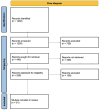Heterosexual Intimate Partner Femicide: A Narrative Review of Victim and Perpetrator Characteristics
- PMID: 40563762
- PMCID: PMC12190878
- DOI: 10.3390/brainsci15060589
Heterosexual Intimate Partner Femicide: A Narrative Review of Victim and Perpetrator Characteristics
Abstract
Background: Intimate partner femicide (IPF) is the most common form of femicide and a severe expression of gender-based violence, highlighting persistent gender inequality worldwide. Addressing this major public health concern requires a comprehensive synthesis of existing evidence to inform prevention strategies. This review aims to identify risk factors for IPF and explore the demographic, behavioral, and psychosocial characteristics of victims and perpetrators. Methods: A narrative review was conducted using a systematic literature search in Scopus, Web of Science, and PubMed, following PRISMA guidelines. Studies were selected based on predefined inclusion and exclusion criteria. Out of 1200 identified records, 51 met the criteria and were included. Data extraction and analysis were conducted independently by two reviewers. Findings are presented narratively. Results: The review identified multiple risk factors for IPF. Victims were more likely to be married, with a history of psychological and physical abuse as well as substance use. Perpetrators were typically older, with higher rates of unemployment, psychiatric disorders, and substance use. Common precipitating factors included jealousy, separation, and recurrent conflicts. Weapon use-particularly knives and firearms-and "overkill" were frequent. Perpetrators often exhibited stalking behaviors and a history of intimate partner violence. Compared to other homicide offenders, IPF perpetrators were generally older, more often employed, and less likely to have a criminal background, but more likely to engage in intimate partner violence and hold patriarchal beliefs. Conclusions: IPF is not an unpredictable act. Despite the heterogeneity among perpetrators, identifiable risk indicators can inform effective prevention and intervention efforts.
Keywords: abuse; femicide; intimate partner violence; mental health; psychological profile.
Conflict of interest statement
All authors report no conflict of interest.
Figures
Similar articles
-
Surveillance for Violent Deaths - National Violent Death Reporting System, 50 States, the District of Columbia, and Puerto Rico, 2022.MMWR Surveill Summ. 2025 Jun 12;74(5):1-42. doi: 10.15585/mmwr.ss7405a1. MMWR Surveill Summ. 2025. PMID: 40493548 Free PMC article.
-
Measures for screening for intimate partner violence: a systematic review.J Psychiatr Ment Health Nurs. 2016 Apr;23(3-4):217-35. doi: 10.1111/jpm.12289. Epub 2016 Mar 31. J Psychiatr Ment Health Nurs. 2016. PMID: 27029235
-
Unveiling the Dark Nexus: A systematic review on the interplay of mental health, substance abuse, and socio-cultural factors in femicide.Leg Med (Tokyo). 2024 Mar;67:102334. doi: 10.1016/j.legalmed.2023.102334. Epub 2023 Oct 7. Leg Med (Tokyo). 2024. PMID: 37838582
-
Population-based interventions for reducing sexually transmitted infections, including HIV infection.Cochrane Database Syst Rev. 2004;(2):CD001220. doi: 10.1002/14651858.CD001220.pub2. Cochrane Database Syst Rev. 2004. Update in: Cochrane Database Syst Rev. 2011 Mar 16;(3):CD001220. doi: 10.1002/14651858.CD001220.pub3. PMID: 15106156 Updated.
-
The effectiveness of interventions to meet family needs of critically ill patients in an adult intensive care unit: a systematic review update.JBI Database System Rev Implement Rep. 2016 Mar;14(3):181-234. doi: 10.11124/JBISRIR-2016-2477. JBI Database System Rev Implement Rep. 2016. PMID: 27532144
References
-
- World Health Organization Violence against Women. 2023. [(accessed on 14 April 2025)]. Available online: https://www.who.int/news-room/fact-sheets/detail/violence-against-women.
-
- Caldwell J.E., Swan S.C., Woodbrown V.D. Gender Differences in Intimate Partner Violence Outcomes. Psychol. Violence. 2012;2:42–57. doi: 10.1037/a0026296. - DOI
-
- Matias A., Gonçalves M., Soeiro C., Matos M. Intimate Partner Homicide: A Meta-Analysis of Risk Factors. Aggress. Violent Behav. 2020;50:101358. doi: 10.1016/j.avb.2019.101358. - DOI
Publication types
LinkOut - more resources
Full Text Sources
Miscellaneous


